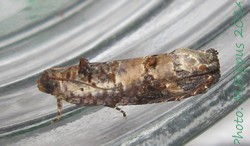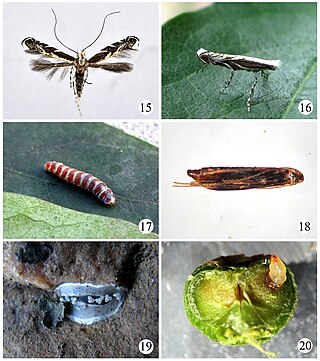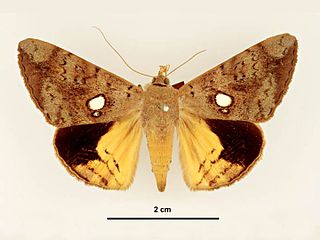
Deudorix epijarbas, the cornelian or hairy line blue, is a species of lycaenid or blue butterfly found in south and southeast Asia from India to Fiji, including the Philippines, and also the tropical coast of Queensland in Australia. The species was first described by Frederic Moore in 1857.

Cryptophlebia ombrodelta, the litchi fruit moth or macadamia nut borer, is a moth of the family Tortricidae. The species was first described by Oswald Bertram Lower in 1898. It is native to India, Sri Lanka, Nepal, Indonesia, China, Taiwan, Vietnam, Thailand, western Malaysia, New Guinea, the Philippines, Japan, Guam, the Caroline Islands, Australia and has been introduced to Hawaii.
Adoxophyes privatana, the appleleaf-curling moth, is a moth of the family Tortricidae. The species was first described by Francis Walker in 1863. It is native to south-east Asia, where it has been recorded from Taiwan, Hong Kong, Hainan in China, Nepal, India, Sri-Lanka, Thailand, Vietnam, western Malaysia, Singapore, Sumatra, Java, Borneo, the Philippines and the Chagos Archipelago. It is an accidental introduction in Great Britain.

Dudua aprobola, the mango flower webworm or litchi leaf roller, is a moth of the family Tortricidae. The species was first described by Edward Meyrick in 1886. It is a pest on several economically important crops.
Acrocercops hierocosma is a moth of the family Gracillariidae. It is known from the Northern Territory of Australia and India.
Conopomorpha heliopla is a moth of the family Gracillariidae. It is known from the Australian states of Tasmania, Queensland and Western Australia.
Conopomorpha chionosema is a moth of the family Gracillariidae. It is known from South Africa, Namibia and Zimbabwe.
Conopomorpha euphanes is a moth of the family Gracillariidae. It is known from South Africa and Namibia.
Conopomorpha fustigera is a moth of the family Gracillariidae. It is known from South Africa and Uganda.

Conopomorpha cyanospila is a moth of the family Gracillariidae. It is known from New Zealand.
Conopomorpha litchiella is a moth of the family Gracillariidae. It is known from Australia, China (Fujian), India, Malaysia (Selangor), Nepal, Taiwan and Thailand.
Conopomorpha oceanica is a moth of the family Gracillariidae. It is known from Fiji and Vanuatu.
The litchi fruit borer or the litchi stem-end borer is a moth of the family Gracillariidae. It is present in China, India, Nepal, Taiwan, Thailand and Vietnam.

Epicephala relictella is a moth of the family Gracillariidae. It is known from the Russian Far East, China and Korea.

Conopomorpha flueggella is a moth of the family Gracillariidae. It is known from Tianjin, China.

Oxyodes tricolor is a species of moth of the family Noctuidae first described by Achille Guenée in 1852. It is found in Australia along the coast of Queensland.

Statherotis discana, the litchi leafroller, is a moth of the family Tortricidae. It is found in Thailand, Taiwan, Japan, the Philippines, India, Java, the Solomon Islands, the Moluccas and New Guinea.
Homona eductana is a species of moth of the family Tortricidae. It is found in India, Thailand, Malaysia, Singapore and China.

Uromycladium tepperianum is a rust fungus that infects over 100 species of Acacia and related genera including Paraserianthes in Australia, south-east Asia, the south Pacific and New Zealand. The acacia gall rust fungus species Uromycladium tepperianum has been introduced to South Africa as a biological control on the invasive Australian shrub Acacia saligna.

Thalassodes immissaria is a moth of the family Geometridae first described by Francis Walker in 1861. It is found in the Oriental tropics of China, India, Sri Lanka, Hong Kong, Japan, Borneo, Vietnam, Sumatra, Sulawesi and the Ryukyu Islands. The populations in Ryukyu were often classified as a subspecies - Thalassodes immissaria intaminataInoue, 1971. However, in 2005 this subspecies was upgraded to a distinct species, which can be distinguished from immissaria by careful examination of the male genitalia.










